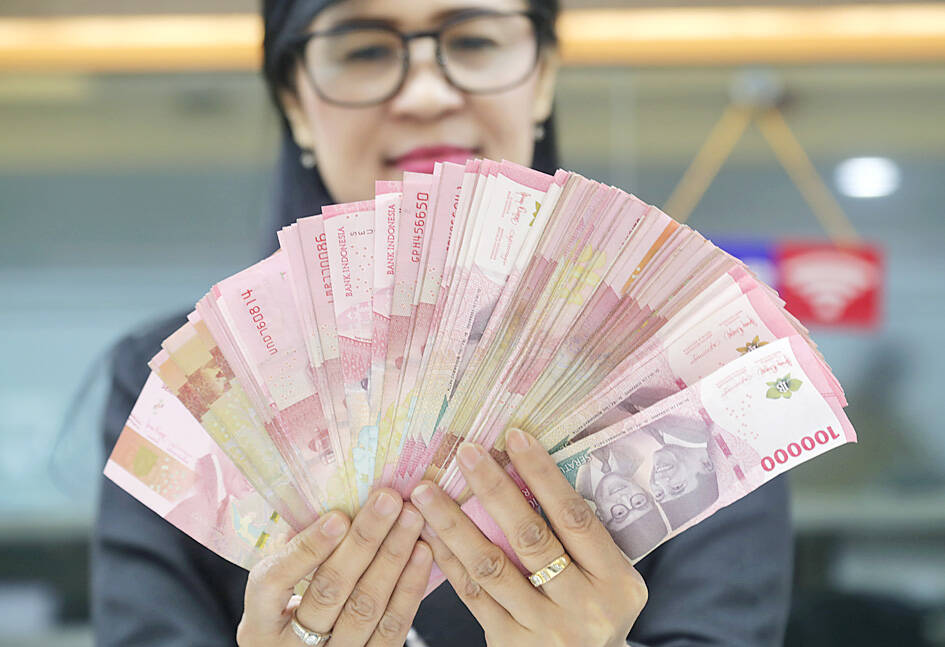Indonesia’s central bank is stepping into the market to support the rupiah that is in its longest losing streak since last year.
Bank Indonesia (BI) is intervening in the spot, domestic non-deliverable forwards and bond markets to maintain currency supply and demand balance, central bank monetary management executive director Edi Susianto said.
“Market confidence needs to be maintained,” Susianto said, adding that the weakness is largely driven by external sentiments.

Photo: Bagus Indahono, EPA-EFE
Susianto’s comments come with the currency set to decline for a sixth straight day. The rupiah along with other emerging market (EM) currencies are coming under depreciation pressure, as signs of resilience in the US economy bolster the US dollar.
“Global market developments have been rather unfavorable for EM currencies, including the rupiah, due to escalating tensions in the Middle East and recent better-than-expected US jobs data,” Susianto said.
The currency weakened as much as 1.3 percent to 15,693 rupiah per US dollar yesterday. It had rallied more than 8 percent in the third quarter on expectations that the US Federal Reserve would persist with heavy rate cuts after its recent half percentage point reduction.
BI was seen supporting the currency in early trading, traders said. That was the first time in months that the central bank had intervened in the market.
The Indonesian central bank has ample resources to support the rupiah, with its foreign exchange reserves remaining near a record. The stockpile stood at US$149.9 billion last month, covering 6.4 months of imports and external debt servicing requirements.
The weakness in the rupiah has lifted expectations that BI might keep its policy rate on hold at its meeting on Wednesday next week after a surprise rate cut last month.
Meanwhile, the New Taiwan dollar ended down NT$0.168, or 0.52 percent, at NT$32.131 against the US dollar in Taipei on Monday, its lowest level since Sept. 10, when it closed at NT$32.173.
Dealers said the US dollar attracted strong buying soon after the local forex market opened, as investors were encouraged by the US nonfarm payroll report, which showed some 254,000 jobs were created last month, beating an earlier market estimate of 150,000.
The robust jobs report might prompt the Fed not to make big rate cuts later this year, following its aggressive 50 basis point reduction last month, dealers said. As a result, the US Dollar index, which traces the value of the currencies of Washington's six major trading partners, rose yesterday, they noted.
According to Taiwan's central bank, the US Dollar index rose 0.61 percent yesterday, sending down regional currencies, with the Japanese yen falling 1.33 percent, the South Korea won 0.64 percent and the Singapore dollar 0.54 percent.
The weakness of those Asian currencies put pressure on the NT dollar throughout yesterday's session, dealers said.
Additional reporting by CNA

JITTERS: Nexperia has a 20 percent market share for chips powering simpler features such as window controls, and changing supply chains could take years European carmakers are looking into ways to scratch components made with parts from China, spooked by deepening geopolitical spats playing out through chipmaker Nexperia BV and Beijing’s export controls on rare earths. To protect operations from trade ructions, several automakers are pushing major suppliers to find permanent alternatives to Chinese semiconductors, people familiar with the matter said. The industry is considering broader changes to its supply chain to adapt to shifting geopolitics, Europe’s main suppliers lobby CLEPA head Matthias Zink said. “We had some indications already — questions like: ‘How can you supply me without this dependency on China?’” Zink, who also

The number of Taiwanese working in the US rose to a record high of 137,000 last year, driven largely by Taiwan Semiconductor Manufacturing Co’s (TSMC, 台積電) rapid overseas expansion, according to government data released yesterday. A total of 666,000 Taiwanese nationals were employed abroad last year, an increase of 45,000 from 2023 and the highest level since the COVID-19 pandemic, data from the Directorate-General of Budget, Accounting and Statistics (DGBAS) showed. Overseas employment had steadily increased between 2009 and 2019, peaking at 739,000, before plunging to 319,000 in 2021 amid US-China trade tensions, global supply chain shifts, reshoring by Taiwanese companies and

Taiwan Semiconductor Manufacturing Co (TSMC, 台積電) received about NT$147 billion (US$4.71 billion) in subsidies from the US, Japanese, German and Chinese governments over the past two years for its global expansion. Financial data compiled by the world’s largest contract chipmaker showed the company secured NT$4.77 billion in subsidies from the governments in the third quarter, bringing the total for the first three quarters of the year to about NT$71.9 billion. Along with the NT$75.16 billion in financial aid TSMC received last year, the chipmaker obtained NT$147 billion in subsidies in almost two years, the data showed. The subsidies received by its subsidiaries —

At least US$50 million for the freedom of an Emirati sheikh: That is the king’s ransom paid two weeks ago to militants linked to al-Qaeda who are pushing to topple the Malian government and impose Islamic law. Alongside a crippling fuel blockade, the Group for the Support of Islam and Muslims (JNIM) has made kidnapping wealthy foreigners for a ransom a pillar of its strategy of “economic jihad.” Its goal: Oust the junta, which has struggled to contain Mali’s decade-long insurgency since taking power following back-to-back coups in 2020 and 2021, by scaring away investors and paralyzing the west African country’s economy.